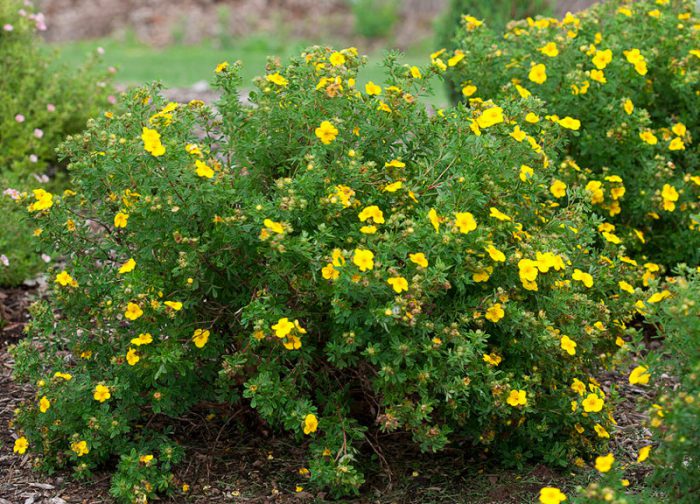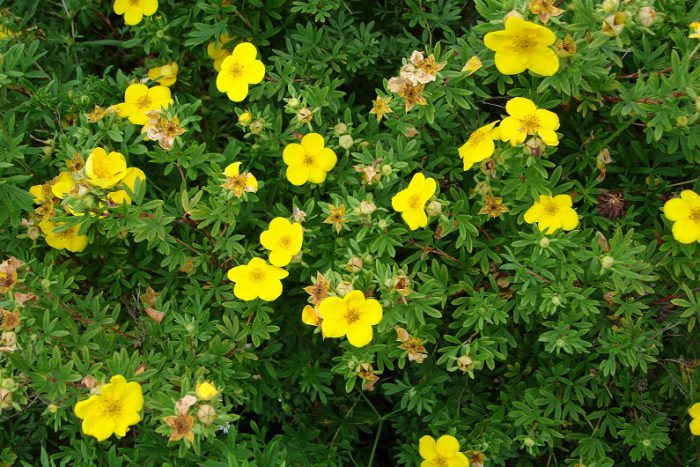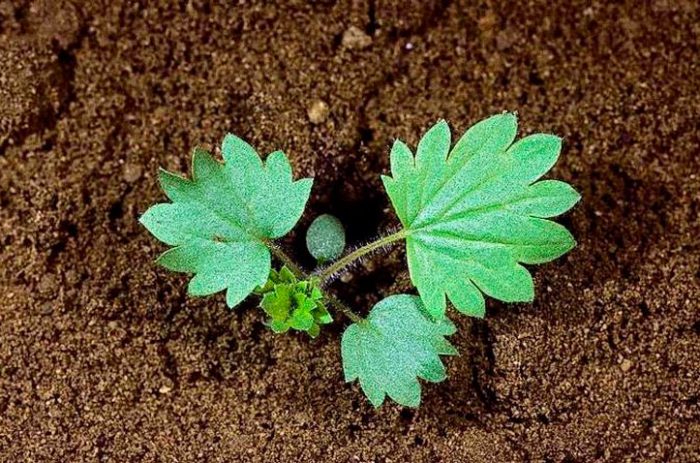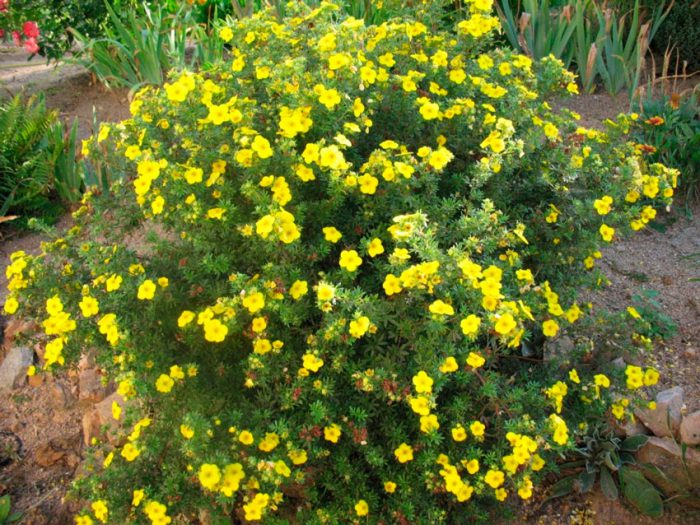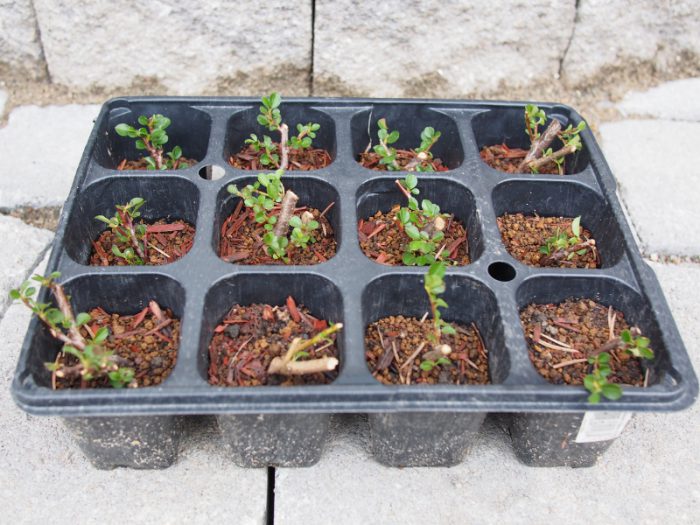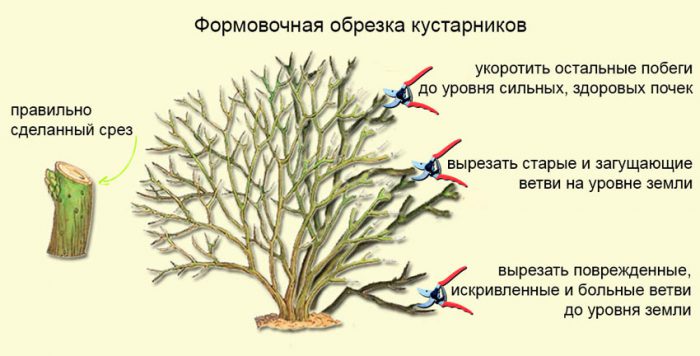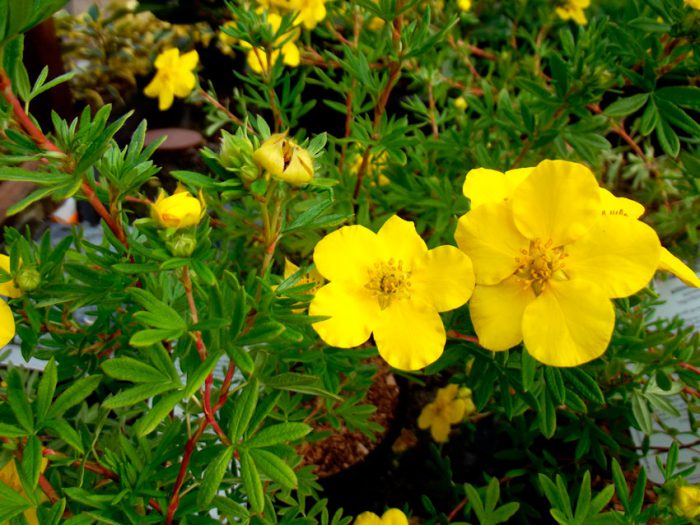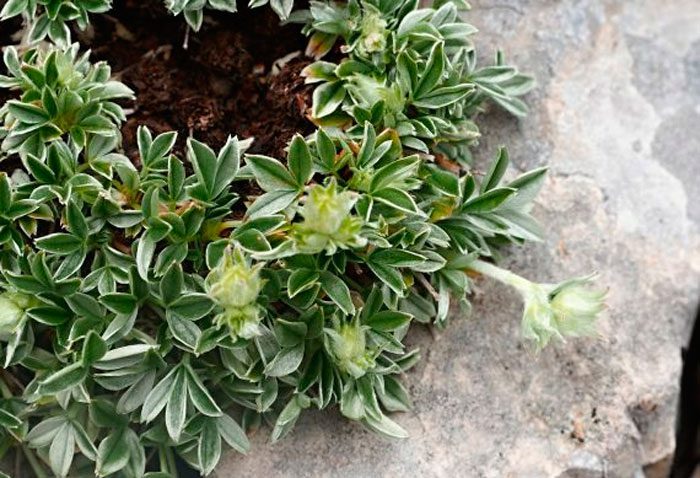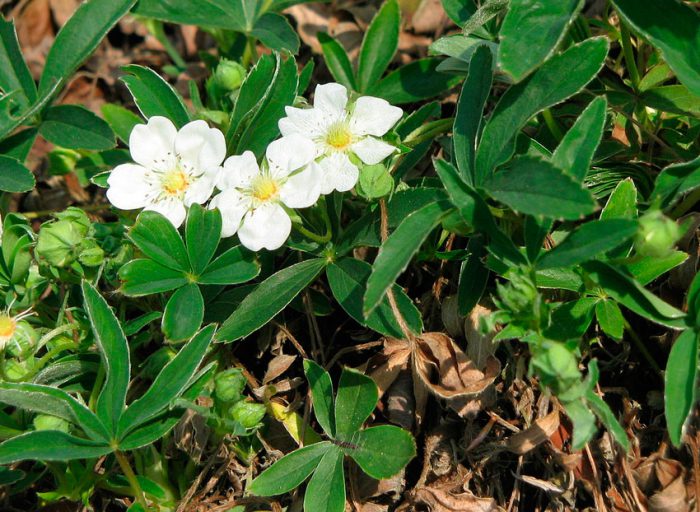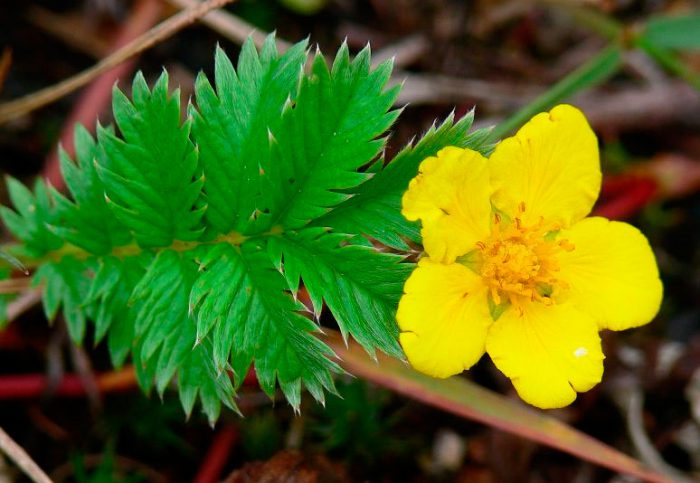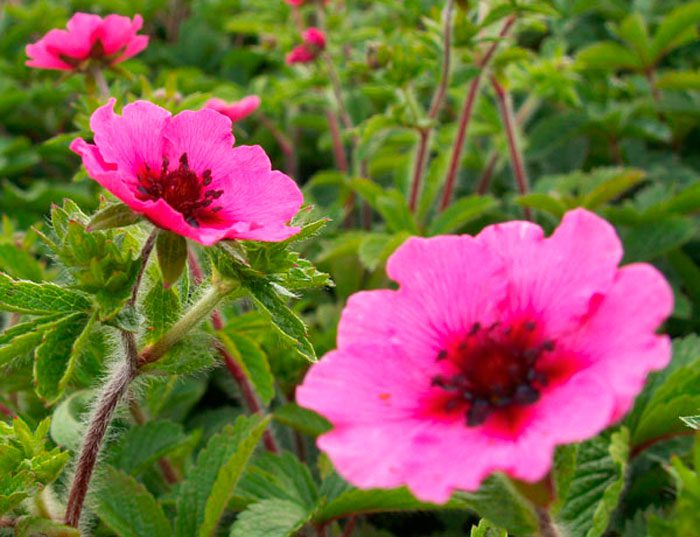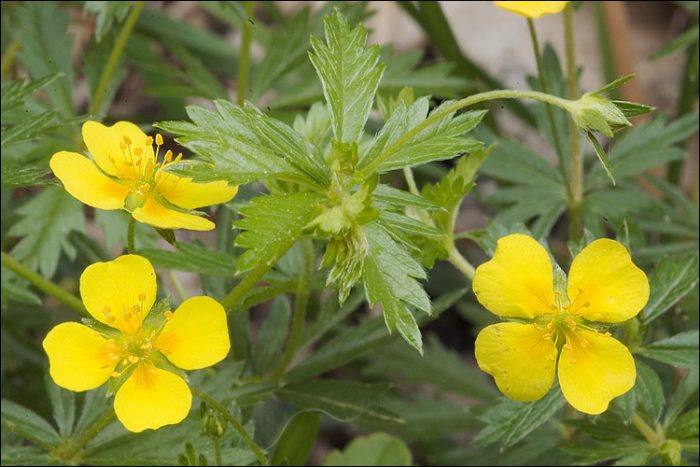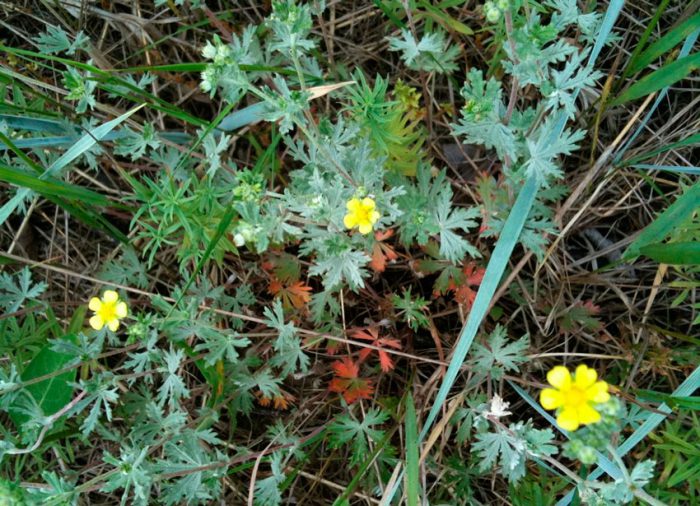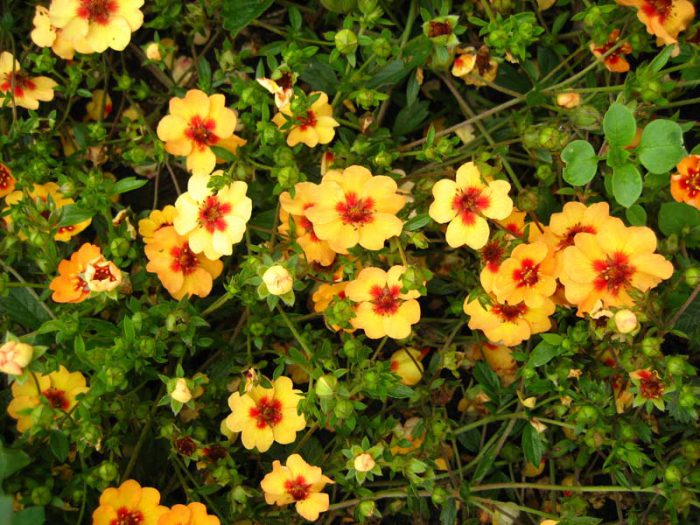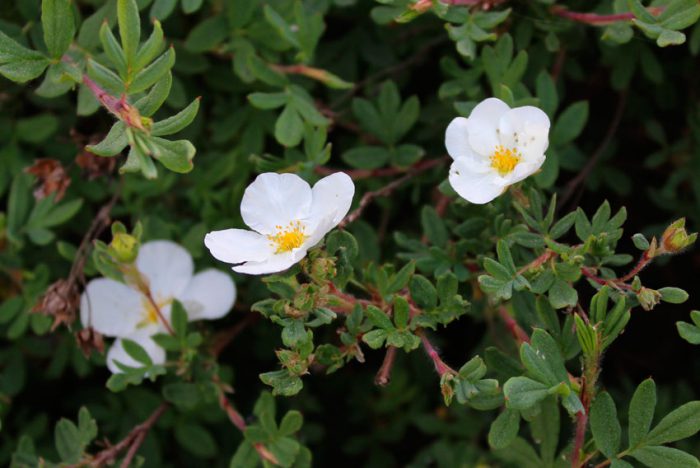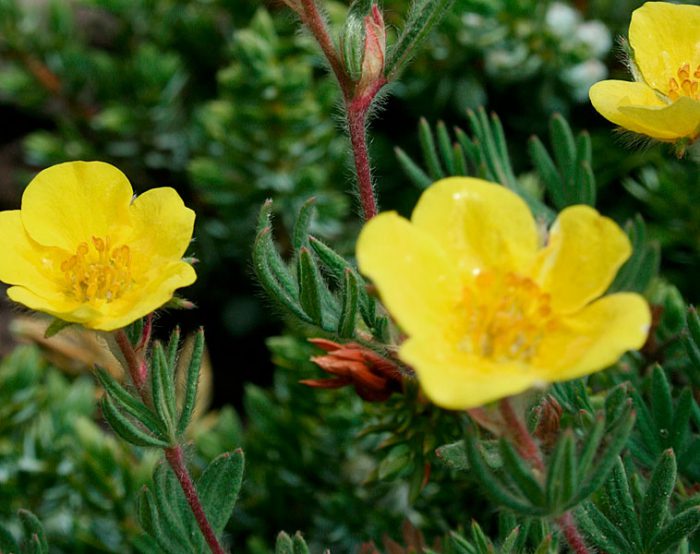Cinquefoil (Potentilla) belongs to one of the largest genera in terms of the number of species, which is part of the pink family. Its striking representatives are erect cinquefoil (galangal-grass) and cinquefoil goose. Most of the species of this genus in natural conditions can be found in the Northern Hemisphere. Cinquefoil comes from the Latin word "potent" - "powerful, strong". Apparently, this refers to the incredible healing power of individual representatives of this kind. All over the world there are about 500 species of Potentilla, which are represented mainly by herbaceous plants, but there are also shrubs among them. At the same time, both grass and shrubs belonging to this genus are cultivated in gardens. The cinquefoil shrub in Russia is called Kuril tea or five-leafed, while there is an old legend that tells about Ilya Muromets, the smell of cinquefoil gave him unprecedented strength. Russian healers also call cinquefoil a mighty man, and since ancient times it has been used to heal a variety of ailments, as well as to restore strength. Today, this plant is mostly used as a decorative plant, and experts plant it on a green lawn as a tapeworm, and they also decorate curbs, alpine slides and hedges.
Content
- 1 Features of Potentilla
- 2 Planting Potentilla
- 3 Potentilla care
- 4 Cinquefoil after flowering
- 5 Types and varieties of Potentilla with photos and names
- 5.1 Apennine cinquefoil (Potentilla apennina)
- 5.2 White cinquefoil (Potentilla alba)
- 5.3 Cinquefoil goose, or goose foot (Potentilla anserina)
- 5.4 Nepalese cinquefoil (Potentilla nepalensis)
- 5.5 Erect cinquefoil, or straight, or galangal (Potentilla erecta)
- 5.6 Silver cinquefoil (Potentilla argentea)
- 5.7 Hybrid cinquefoil (Potentilla x hybrida)
- 5.8 Pentaphylloides davurica (Pentaphylloides davurica)
- 5.9 Pentaphylloides bush (Pentaphylloides fruticosa)
- 6 Useful properties and contraindications
Features of Potentilla
Representatives of this genus are shrubs and herbaceous plants, which can be annuals, biennials and perennials. Shoots of such plants are often erect, ascending or widened, and creeping are also found. The leaf plates are pinnate or multipart, and they are painted grayish-green or green. The height of semi-shrubs can reach 150 centimeters, while their diameter sometimes reaches 100 centimeters.In most species, flowers are part of corymbose-paniculate or pseudo-umbellate inflorescences, however, species with single flowers are also found. They can be painted in a wide variety of colors, such as golden yellow, pink, white, red, orange and cream. Long bloom is observed in May-September. The fruit contains many achenes (10–80 pieces), most often they are naked, but they can be hairy. Moreover, the larger the size of the fruits, the more exotic the type of such a plant.
Planting Potentilla
Almost all representatives of this genus are distinguished by their undemanding growing conditions, with the exception of Shiny Potentilla, which is recommended to grow in the southern exposure, choosing dry sandy soil for it, as well as White Potentilla - it likes to grow in a shaded place. For the remaining species, they are best suited to well-lit areas that should be shaded in the afternoon with other plants. The soil they need is slightly acidic, loose, saturated with nutrients, and also well-drained, which has a little lime in its composition. It should be remembered that the Arctic Potentilla needs acidic soil.
How to grow herbaceous cinquefoil from seeds
Cinquefoil can be propagated by various methods, for example, grown from seeds. Experts advise to sow directly into open soil in the fall. In winter, such seeds undergo natural stratification, due to which in spring they give amicable shoots and they only need to be planted. Sowing can be done in open ground and in spring. However, a more reliable way is to grow through seedlings. To do this, sowing seeds should be done in February or March, while the container must be covered with a film before the first shoots appear and removed to a place with a temperature of 15 to 18 degrees. After the shoots have real leaf blades, they are picked in peat-baked or individual cups. The growth of the seedlings is relatively slow, but already at the end of the summer period, the seedlings can be transplanted to a permanent place in open soil. Young plants will need shelter to survive the winter. The flowering of cinquefoil grown from seeds is observed only in the second year. These plants reproduce well by self-seeding.
How to plant shrub cinquefoil
In early spring, after the snow cover melts, and the soil warms up a little, you should start planting shrub seedlings. The width and depth of the pit should be a couple of times larger than a clod of earth or a container in which the seedling grows. If you are planting several bushes, then remember that the distance between them should be 0.3 m.A drainage layer should be made at the bottom of the hole; for this, lime gravel is poured into it. Then the ½ part hole should be filled with soil mixture, which includes leafy earth, humus and sand (2: 2: 1), and it is imperative to add 150 grams of complex mineral fertilizer to it. When placing a seedling in a planting hole, it should be noted that its root collar should rise slightly above the soil surface. Then the pit should be filled with soil, which must be well compacted. The planting needs to be watered abundantly. For 20 days, it is necessary to ensure that the Potentilla always has a sufficient amount of water. In order to reduce the rate of drying of the soil, it should be sprinkled with a layer of mulch (bark, straw or sawdust). If necessary, you can plant Potentilla in the last summer or first autumn days.
Potentilla care
It is quite simple to grow Potentilla, and it does not matter whether it is a shrub or a herbaceous plant. For normal growth and development of the plant, it is necessary to regularly water, loosen the surface of the soil, remove weeds, feed, remove fading flowers, and also mulch the soil on the site.Watering should be done only with prolonged drought, while 10 liters of lukewarm water should be poured under each bush 1 time in half a month. In the event that in the spring time you sprinkle the area with mulch (sawdust or peat), then removing weeds and loosening the soil will need to be carried out relatively rarely. During the summer period, add mulch to the site 2 or 3 times. Top dressing is done three times a season (in May, July and in August or September), while using mineral fertilizer for flowering plants. For more lush flowering, it is also recommended to spray the cinquefoil with water in the evening after a hot day.
Reproduction of Potentilla
In addition to the fact that Potentilla is grown from seeds, it can be propagated by cuttings, layering and dividing the bush. Potentilla can be propagated by layering and cuttings in July or August, and it is recommended to divide the bush in spring (April or May) or autumn (first days of September). A specimen that is at least four years old is suitable for division, it must be dug up, the rhizome is washed with water from a hose, and then divided into divisions using a very sharp, pre-sterilized knife. It should be remembered that there should be 2 or 3 kidneys on each division. In the cases, it is necessary to process the roots with a means that stimulates their growth. Then they are planted in the soil, while the buds should not be buried. Remember to leave 20 to 40 centimeters of empty space between the divisions.
The length of the cuttings varies from 8 to 10 centimeters, while they are harvested from the ends of the stems, having previously cut off all the flowers. For rooting, moistened perlite is used, it lasts for 4-6 weeks, while keeping the cuttings in a room that does not freeze. Cuttings can also be rooted directly in open soil by choosing a place for this in partial shade, while it is recommended to use a glass jar or a cut bottle as a shelter. They should be sprayed several times a day. The buds that appear should be removed, because they can greatly weaken the plant. For wintering, they need to be covered with spruce branches.
It is easiest to propagate cinquefoil by layering. In springtime, you should look for a stem that grows very close to the soil surface. An incision must be made on its outer side. Then it is placed in the prepared groove with a cut down, fixed in this position (necessarily in this place) and covered with soil. With the onset of autumn, the cutter should develop a good root system. In this case, it should be cut off from the mother bush and planted in a permanent place.
Pruning Potentilla
Shrub cinquefoil needs mandatory pruning, which must be done in early spring, before the buds open, and also in autumn. In the event that pruning is not done, then the bush becomes shaggy and looks sloppy. Pruning can be sanitary, during which it is necessary to cut off all injured, dried out branches, as well as those that grow inward. Also, this procedure can be carried out in order to form a bush, and often it is given a pillow or spherical shape. In spring, last year's increments are shortened by 1/3, and in the fall, old and elongated stems should be cut off. Such a shrub will need rejuvenating pruning once every 5 years, or it is carried out when many dried branches are found. To make such a pruning, it is necessary to cut off a third of the dried branches for 3 years in a row. This will lead to a complete renewal of the bush.
Diseases and pests
This plant is highly resistant to various diseases and harmful insects, which greatly facilitates its care. In rare cases, cinquefoil can get sick with spotting, rust or powdery mildew.In the event that one of these diseases struck the annual cinquefoil, then you should not worry, because this will not greatly affect the appearance of the bush, and in the autumn it will still have to be disposed of. If you have a perennial plant, then it is recommended to use a fungicide for its treatment (for example, colloidal sulfur or Bordeaux liquid). Also, in rare cases, scoops can settle on the bush. In order to get rid of them, treat the affected specimen with an insecticide (for example, Decis Profi, Fufanon or Fitoverm).


Watch this video on YouTube
Cinquefoil after flowering
Autumn care
In autumn, the annual Potentilla should be removed from the site after its appearance becomes unattractive, while it is necessary to dig the site with fertilizer. In shrub Potentilla, when it finishes blooming, all shoots should be shortened by 1/3, and for the prevention of diseases, the bushes should be treated with Bordeaux liquid.
Wintering
A perennial cinquefoil does not need shelter for the winter, because it has a high frost resistance, and it does not matter whether it is a herbaceous plant or a shrub. Shelter is needed for young seedlings, planted in autumn, and rooted cuttings.
Types and varieties of Potentilla with photos and names
There are many types of Potentilla, and there are several times more varieties. Therefore, only those varieties and species that are most popular will be presented below.
The herbaceous species that are most popular are:
Apennine cinquefoil (Potentilla apennina)
This perennial plant has a leaf rosette consisting of trifoliate leaf plates with silvery pubescence. The color of the flowers is white or pink.
White cinquefoil (Potentilla alba)
In nature, it can be found in the central regions of the European part of Russia, in the Balkans and the Caucasus. The height of such a perennial plant varies from 8 to 25 centimeters, complex basal leaf plates are palmate-lobed, while they have brown stipules. Loose racemose or umbellate inflorescences consist of several white flowers with a three-centimeter diameter. The height of the peduncles is about 25 centimeters, the stem leaves are absent.
Cinquefoil goose, or goose foot (Potentilla anserina)
Peristocomplex leaf plates are collected in a basal rosette and reach 20 centimeters in length, there is pubescence on their seamy surface. On leafless peduncles, single yellow flowers flaunt, which can reach 20 mm in diameter.
Nepalese cinquefoil (Potentilla nepalensis)
This perennial can reach half a meter in height, its straight branched shoots are purple in color. The length of the dark green palmate leaf plates is about 0.3 m. The diameter of the flowers is about 30 mm, their color can be pale pink or red, and the veins are dark pink. Flowers are part of paniculate inflorescences. Flowering begins in July and lasts about 8 weeks. The most decorative varieties:
- Roxanne... On the surface of the salmon-orange flowers, there are streaks of dark color.
- Miss Wilmott... It blooms magnificently and for a relatively long time. Cherry pink flowers have a dark eye.
- Floris... The light salmon flowers are decorated with an orange-red eye.
Erect cinquefoil, or straight, or galangal (Potentilla erecta)
In nature, this kind can be found in the forest and tundra zone, while these flowers grow on lawns and forest edges, along the banks of swamps and rivers. Such a perennial has a woody rhizome, which is unevenly thickened. The height of the erect stem reaches 20 centimeters, leaves are located on its upper branchy part. Trifoliate leaf plates can be sessile and long-petiolate basal plates (wither before flowering). Regular single flowers can reach 10 mm in diameter; they are located on thin long pedicels.Bloom is observed from June to August.
Silver cinquefoil (Potentilla argentea)
This perennial has a large tuberous rhizome. The height of a slender arcuate rising shoot can reach up to 0.3 m. The lower-stem and basal leaf plates are five to seven-part long-scaled, and the upper-stem and middle ones are three to five-part, on the seamy surface there is a dense coating consisting of white pile. The loose paniculate-corymbose inflorescence includes small flowers, the diameter of which is 1.2 centimeters. Bloom is observed in June and July.
Hybrid cinquefoil (Potentilla x hybrida)
This species includes garden forms and varieties of hybrid origin. Most of the plants have a vertical or oblique rhizome. The height of erect, strongly branching stems reaches 0.9 m, there is pubescence on their surface. Basal rosette consists of palmate or triple long-petiolate leaf plates with sharp teeth along the edge. The triple stem leaves are sessile. The loose corymbose or racemose inflorescence includes velvety flowers reaching 40 mm in diameter, their color can be yellow, pink, red or dark purple.
Popular varieties:
- Master Floris... Lush and long flowering. Large, simple flowers are pale yellow in color.
- Yellow Queen... The bush reaches a height of 0.3 m, and yellow glossy flowers flaunt on it.
- Volcano... Terry flowers, deep red color.
Potentilla is also very popular: two-flowered, golden, long-leaved, shaggy, Kranza, deceptive, tansy, dark blood-red, silver-leaved, Tonga, tridentate, shiny, stemless, snow-white, arctic, etc.
Of the shrubs, gardeners cultivate the Kuril cinquefoil (Pentaphylloides fruticosa), which is also called Kuril tea, yellow cinquefoil and five-leafed. Experts previously attributed this species to Potentilla, but not so long ago they isolated it in a separate genus, called Kuril tea, Dasiphora (Dasys - thick-haired, phoros - carrying). This genus consists of 10 species, a large number of varieties and garden forms, which are honey plants, have already been created from them. Designers often create a very effective hedge from such shrubs.
Pentaphylloides davurica (Pentaphylloides davurica)
The height of such a shrub can reach up to 0.6 m. Its bare stems are spaced apart. Almost leathery five-part leaf plates have a bluish seamy surface and a glossy front surface. The diameter of the white flowers is about 25 mm, they are often solitary, but in some cases they can be part of a few-flowered umbrella-shaped inflorescences. Long bloom, more than 3 months. Cultivated since 1822.
Pentaphylloides bush (Pentaphylloides fruticosa)
In nature, it can be found in forest-steppe and forests, Russia, Central Asia, Western Europe and the Caucasus. This shrub is distinguished by its high endurance. The height of a highly branching bush can reach 150 centimeters, the peeling bark is colored brown or gray. The lush crown has a hemispherical shape. All-edge lanceolate leaf plates have a length of 30 mm and a width of 10 mm, they can be three to five to seven-part. Young leaves have a light green color, but over time it changes to green-silver, as pubescence appears. Yellow-golden flowers have a diameter of 20 mm, while they can be single or collected in loose apical racemose or corymbose inflorescences. Flowering lasts from the second half of June to the first days of October. Cultivated since 1700 In America and European countries, as a rule, cultivars of this type are grown, because they are the most resistant to such climatic conditions.
Popular undersized varieties: Abbotswood, Jolina, Dakota Sunrise, Goldstar, Goldfinger, Reisenberg (flower color varies in orange-yellow range), Farrez White and Rodokelix (white flower color).
Winter-hardy tall varieties include the Elizabeth and Catherine Dykes varieties with yellow flowers. The height of the bushes reaches over 100 centimeters.
Winter-hardy varieties with grayish-silvery leaf plates include Goldterppich, Darts Golddigger, Bisi.
Low-growing compact varieties that are not frost-resistant and need shelter for the winter: Klondike, Kobold (yellow flowers), Red Ice, Parvifolia, Red Robbin (copper-yellow flowers), Sunset (brick-red to orange-yellow flowers ), Eastleigh Cream (cream-white flowers), Royal Flash, Daydown, Pritty Polly and Blink (pink flowers).
Also of particular interest are the following species: small-leaved five-leaved, dryadiflorous, Manchurian and Friedrichsen. They are still poorly understood by breeders.
Useful properties and contraindications
Useful properties of Potentilla
Medicinal properties were observed mainly in only 3 species of herbaceous Potentilla, namely: goose, white and galangal (erect). The properties of these species have minor differences. Therefore, it does not really matter from which particular plant this or that medicine is made, intended for external use. As a result of numerous studies, it became clear that extracts made from rhizomes or herbs are not toxic and have almost equal healing power. If you take medicinal products from the white cinquefoil herb inside, then the central nervous system (central nervous system) is stimulated, while the extract from the rhizome makes the filtering ability of the kidneys 28 percent better. Kalgan is used, as a rule, for various disorders of the gastrointestinal tract (for example, colitis, dysentery), which are accompanied by diarrhea. Also, this plant is used in the treatment of liver diseases, which are manifested by jaundice, for example, hepatitis. Today galangal is also used by official medicine for inflammation of the thyroid gland. In this case, a tincture of Potentilla on alcohol is used, which is taken according to the scheme recommended by the doctor inside, while at the same time treatment with medicines is carried out, such therapy has a fairly high efficiency. It is not difficult to prepare a tincture, for this you need to take a dry rhizome and grind it, it should be insisted on vodka, then the resulting drink must be filtered. Kalgan is considered a unique plant, since it contains almost all the elements from the periodic table, namely: gallotanin, phenol carboxylic acids, starch, saponins, flavonoids (rutin, quercetin, cyanidin, kaempferol), iridoids, iodine, magnesium, copper, zinc , iron, cobalt, silicon, aluminum. Moreover, it is known that the rhizome contains a greater amount of these substances than in the aerial part of the flower.
The healing power of erect cinquefoil has also been known since ancient times. The composition of this plant includes such substances as: tanning, and also essential oils, flavonoids, ellagic, malic and chitinic acids, wax, starch and gum, as well as vitamin C. Such a plant has an antibacterial, bonding and anti-inflammatory effect. An essential oil is obtained from this flower, which helps in the treatment of certain female diseases. Various decoctions and tinctures are prepared from it, which are used externally in the treatment of atopic dermatitis, for douching for gynecological diseases, for eczema, and they rinse the mouth and larynx with them in the presence of inflammation. Infusions and decoctions made from shoots, leaves, and plant flowers are used in the treatment of chronic and acute hepatitis, as well as in cirrhosis with congestion (significantly reduces the level of bilirubin in the blood and eliminates puffiness).If you use remedies made from such a plant in treatment, then remember that they can cause constipation, because there are many tannins in Potentilla.
The composition of goose cinquefoil also includes essential oils, starch, flavonoids, tannins, as well as bitterness, choline, quinic and ascorbic acid, zinc and other substances that are useful for the human body. Any part of such a plant has healing properties. A decoction prepared from the rhizome is used for the external treatment of abrasions, bruises, wounds, hematomas, neurodermatitis and weeping eczema. Also, this broth is used for douching for a variety of gynecological inflammations, as well as for the treatment of hemorrhoids, while the result of such treatment is very good. It is also used in the treatment of duodenal and stomach ulcers, as well as in acute intestinal infections and hepatitis. A decoction in milk is prepared from the seeds, which is used for painful menstruation, gastroenteritis and spastic colitis. A decoction of the root and grass, cooked in water, effectively eliminates cramps in the calf muscles. Freshly prepared herbal infusion is used externally in the treatment of trophic ulcers and pustular lesions of the epidermis, and it is also used in the treatment of inflammation of the oral mucosa, with pharyngitis and sore throat. As a choleretic agent that is able to remove small stones and sand, fresh juice of this plant is used, combined with green rye juice in a 1: 1 ratio.
From shrubs, healing properties were noted in Kuril Potentilla, while using the tops of young stems. This plant has a diuretic, anti-ulcer, hemostatic, antiviral, analgesic, choleretic, fastening, sedative, antidiabetic, anti-allergenic and immunostimulating effect. It is used in the treatment of female and gastrointestinal diseases, abscesses, boils and other wounds, and they also rinse their mouth for stomatitis, sore throat and other inflammatory diseases. It is used for constipation and diarrhea, dysbacteriosis, stomach ulcers, colitis, cervical erosion and uterine bleeding.
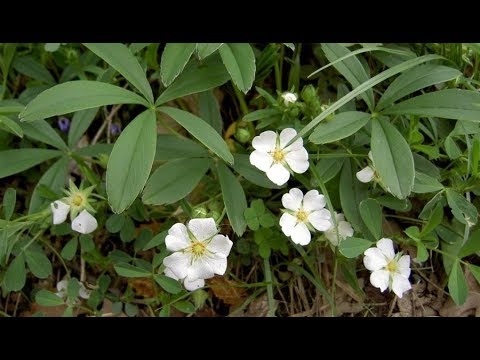

Watch this video on YouTube
Contraindications
It is impossible to use preparations from Potentilla for those people who have increased blood clotting, hypotonic, and also prone to blood clots, because such drugs can lower blood pressure. If you want to remove stones and sand from the ducts with the help of this plant, then this should be done exclusively under the supervision of the attending doctor. It should also be remembered that such agents can irritate the stomach lining. And also they cannot be used during pregnancy and with individual intolerance to Potentilla.


Watch this video on YouTube

